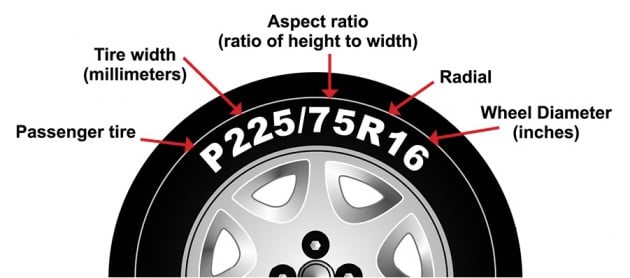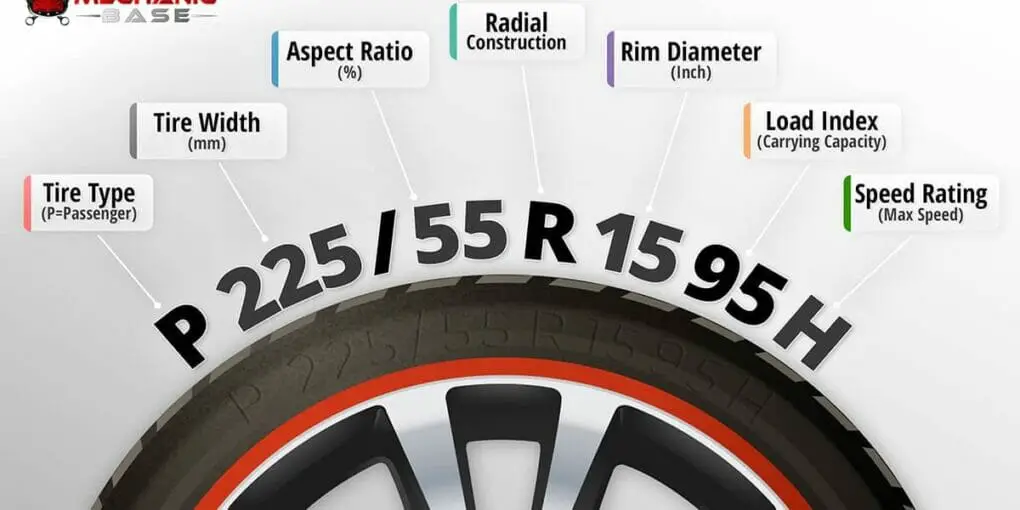How Tire Size Works? The Complete Guide
Tire size is a bit confusing because it can be measured in metric or inches, and the numbers can vary depending on the country you’re in. The width of a tire is the first number listed on the sidewall, and this measurement is taken from bead to bead (the widest part of the tire). The second number is the aspect ratio, which tells you how tall the sidewall is compared to the width.
A lower aspect ratio means a shorter sidewall and a taller tire. The last number is the rim diameter, which is measured in inches.
Tire size is an important aspect of any vehicle, and it is vital to understand how it works. Tire size designations are a combination of numbers and letters that indicate the width, height, diameter, load capacity, and speed rating of a tire. The first number in a tire size designation refers to the width of the tire in millimeters.
The second number is the height, also called the aspect ratio. This number is a percentage of the width, and it indicates how tall the sidewall is. The third number is the wheel diameter in inches.
The load capacity and speed rating are two additional ratings that are usually included in the size designation. The load capacity tells you how much weight each tire can carry safely. The speed rating tells you the maximum speed at which a tire can be used without sustaining damage.
How to Read a Tire Size & Understanding a Tire Sidewall – ABTL Auto Extras
Tire Size Calculator
If you’re shopping for new tires, one of the most important factors to consider is the size. But with all the different sizing conventions and measurements, it can be tough to know what size tire you need. That’s where a tire size calculator comes in.
A tire size calculator is a tool that allows you to input your vehicle information and desired tire size so that you can find the perfect match. All you need is your car’s make, model, and year, plus the specific width, aspect ratio, and diameter (in inches) of the tires you’re interested in. Once you have that information, just plug it into a tire size calculator, and it will do the rest.
There are a few different ways to measure tire sizes, but the most common method is known as “P-metric.” This system uses a combination of numbers and letters to describe a tire’s width, height, aspect ratio, load index, speed rating, and construction type. For example, a P215/65R15 91H would be a 215mm wide tire with a 65% aspect ratio (the sidewall height is 65% of the width), 15″ diameter rim, 91 load index (capable of carrying 1,389 lbs per tire at maximum speed), and H speed rating (130 mph).
Once you know what kind of tires you need for your car or truck – whether it’s all-season or summer performance tires – use our Tire Size Calculator to find options that fit your driving needs.
What is the Aspect Ratio of a Tire?
The aspect ratio of a tire is the ratio of the width of the tire to its height. The higher the aspect ratio, the wider the tire. The lower the aspect ratio, the taller the tire.
The aspect ratio affects the ride quality, handling, and braking of a vehicle.
Changing Tire Size on Same Rim
If you’re looking to change your tire size on the same rim, there are a few things you need to take into account. First, you need to know what sizes will fit onto your rim. Second, you need to consider the width of your tires.
Third, you have to make sure that the new size is compatible with your car’s suspension and drivetrain. And finally, you need to think about the aesthetics of the new setup. Changing tire size can affect a number of things in your car.
The most important thing to consider is compatibility. You need to make sure that the new tires will fit onto your rims without any rubbing issues. The width of the tires is also important.
Wider tires can provide more grip and stability, but they can also make the car harder to handle. Narrower tires might not offer as much grip, but they’ll usually be lighter and easier on gas mileage. Once you’ve chosen the right size, you also have to think about how it will affect your car’s suspension and drivetrain components.
Some setups might not work with certain sizes or widths of tires. It’s always best to consult with a professional before making any changes like this. Finally, don’t forget about aesthetics!
Changing tire size can really change the look of your car for better or for worse. Make sure that you’re happy with how everything looks before committing to any changes.
How to Read Tire Sizes in Inches?
Tire sizes can be a bit confusing, but once you understand the code, it’s pretty easy to read them. The first number is the width of the tire in millimeters. The second number is the height of the sidewall as a percentage of the width.
The third number is the diameter of the wheel in inches. For example, a tire size might look like this: 225/50R17. The first number, 225, is the width of the tire in millimeters.
The second number, 50, is the height of the sidewall as a percentage of the width. In other words, this tire has a sidewall that is 50% as tall as it is wide. The R17 tells us that this tire is designed for a 17-inch wheel.

Credit: www.fiix.io
What Do the 3 Numbers Mean on Tire Size?
When it comes to understanding tire size, there are three numbers that are important to know. These numbers will tell you the width, aspect ratio, and diameter of the tire. Here is a breakdown of what each number means:
Width: This is the measurement of the tire from sidewall to sidewall in millimeters.
Aspect Ratio: This is the ratio of the height of the tire’s sidewall to the width. It’s represented as a percentage.
For example, if a tire has an aspect ratio of 50%, that means that its sidewall is half as tall as it is wide. Diameter: This is the measurement of the wheel from one end to the other in inches.
What Does the 265 70R17 Mean?
The 265 70R17 is a tire size designation. The 265 is the width of the tire in millimeters. The 70 is the ratio of the sidewall height to the width and is expressed as a percentage.
In this case, it means that the sidewall height is 70% of the width of the tire. The R stands for radial construction, and 17 is the diameter of the wheel in inches.
What Does R17 Mean?
R17 is a zoning designation that indicates an area is intended for residential use. The “R” stands for Residential, while the number following it corresponds to the density of housing allowed in that zone. In general, the higher the number after the “R”, the dense the housing can be.
So, R17 would allow for more houses to be built on a given piece of land than R1 or R2 zoning would. The specific regulations governing what can be built in an R17 zone vary from place to place and are set by local governments. However, in most cases, R17 zones are intended for single-family homes or small multifamily dwellings such as duplexes or triplexes.
This means that large apartment buildings would not typically be allowed in an R17 zone. If you’re looking to buy a property with the intention of building a home on it, pay close attention to the zoning designation. If it’s zoned for residential use ( indicated by an “R” followed by a number), then you should be able to build a dwelling there without any trouble.
But if it’s zoned for commercial or industrial use (indicated by a “C” or “I”), then you’ll likely need to get special permission from your local government before proceeding with construction.
What is Meant by 33 Inch Tires?
33-inch tires are a popular size for many trucks and SUVs. They offer a good balance of grip and comfort and can be used on a variety of terrain. There are a few things to consider when shopping for 33-inch tires.
First, you need to make sure that your vehicle can accommodate the larger size. Some vehicles may require modifications to do this, such as installing suspension lift kits. Second, you’ll want to pay attention to the load capacity of the tire.
Make sure that it is rated for the weight of your vehicle, as well as any cargo or passengers you may be carrying. Third, consider the tread pattern of the tire. A mud-terrain tire will offer more grip in off-road conditions, while an all-season tire will be better suited for everyday driving.
Finally, think about your budget. 33-inch tires can be expensive, so make sure you shop around to find the best deal.
Conclusion
When it comes to tires, size matters. But how do you know what size tire is right for your vehicle? In this blog post, we’ll break down the basics of tire sizing so you can make an informed decision when it’s time to buy new tires.
The first thing to know about tire sizing is that there are two different systems in use: metric and standard. Metric sizes are used mostly in Europe and Asia, while standard sizes are used in the United States. There are three main parts to a tire’s size designation: the width, the aspect ratio, and the diameter.
The width is the measurement from one side of the tire to the other and is given in millimeters (mm). The aspect ratio is the height of the sidewall as a percentage of the width. The diameter is the measurement of the wheel from one side to another and is given in inches.
To put it all together, let’s look at an example: a 225/50R16 91V tire. In this case, 225 is the width (in mm), 50 is the aspect ratio (the sidewall height is 50% of the width), R16 means that it’s a radial tire with a 16-inch diameter, 91V means that it has a load index of 91 (which corresponds to a maximum weight capacity of 1,377 pounds) and a speed rating of V (which means it can be driven up to 149 mph). Confused yet?
Don’t worry – we’ve got plenty more information on our website about how Tire Size Works.


